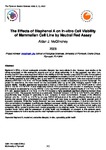The Effects of Bisphenol A on in-vitro Cell Viability of Mammalian Cell Line by Neutral Red Assay
| dc.contributor.author | McGlinchey, A.J. | |
| dc.date.accessioned | 2019-05-13T09:58:33Z | |
| dc.date.available | 2019-05-13T09:58:33Z | |
| dc.date.issued | 2009 | |
| dc.identifier.citation |
McGlinchey, A.J. (2009) 'The Effects of Bisphenol A on in-vitro Cell Viability of Mammalian Cell Line by Neutral Red Assay', The Plymouth Student Scientist, p. 25-31. | en_US |
| dc.identifier.issn | 1754-2383 | |
| dc.identifier.uri | http://hdl.handle.net/10026.1/13850 | |
| dc.description.abstract |
Bisphenol-A (BPA), a known oestrogenic endocrine disruptor, has many effects in-vivo. However, most studies on its effects concentrate on this oestrogenic property and not on direct cytotoxicity. An in-vitro approach was taken here, showing that BPA has a dose-dependent effect on the viability of Chinese hamster ovary (CHO-K1) cells. Concentrations at which BPA directly generates cytotoxic effects were investigated by exposing CHO-K1 to BPA for 48 hours at 37oC and their viability assessed by their ability to take up and retain the neutral red staining agent. Cells were exposed to tenfold dilutions of BPA from 1x10-4M to 1x10-9M and viability measured as a function of absorbance at 540nm wavelength. The greater the absorbance, the more neutral red was successfully taken up by the cells, indicating superior health and general viability. Resulting absorbances ranged from a mean of 2.435A (SEM 0.162) for 1x10-9M BPA down to 1.924A (SEM 0.103) for 1x10-4M BPA. A clear relationship between BPA concentration and reduction in absorbance emerged after exposure as assessed by one-way ANOVA. A one-way ANOVA performed on stacked results of 1x10-4M to 1x10-6M BPA and stacked results of 1x10-7M to 1x10-9M BPA revealed a highly statistically significant difference between these groups (p=0.000). This suggests that there is a cytotoxicity “threshold” between 1x10-7M to 1x10-6M BPA, over which a proportionately large increase in cytotoxicity is seen, compared to lower concentrations. Analysis of the difference between only the 1x10-7M to 1x10-6M by one-way ANOVA fell just short of the 95% confidence interval (p=0.058), showing that around these concentrations is where further work need focus to ascertain a highly accurate point of increased cytotoxicity. Whilst this “toxicity threshold” has been elucidated by these analyses, it must be noted that the other concentrations investigated most likely also displayed decreased viability compared to control medium. However, for reasons presented in this paper, the control measurements made were not reliable and so further control testing and comparison will be needed to provide much-needed perspective on the obtained results. The cytotoxic “threshold” of BPA revealed herein further calls for assessment of public health and investigation of exposure to this cytotoxic agent. Recommendations for further studies and the wider implications of the concentrations investigated here are also given in this paper. | en_US |
| dc.language.iso | en | en_US |
| dc.publisher | University of Plymouth | |
| dc.rights | Attribution 3.0 United States | * |
| dc.rights.uri | http://creativecommons.org/licenses/by/3.0/us/ | * |
| dc.subject | bisphenol A | en_US |
| dc.subject | neutral red | en_US |
| dc.subject | endocrine disruptor | en_US |
| dc.subject | in-vitro | en_US |
| dc.subject | cytotoxicity | en_US |
| dc.subject | public health | en_US |
| dc.subject | oestrogenic | en_US |
| dc.subject | cytotoxic | en_US |
| dc.title | The Effects of Bisphenol A on in-vitro Cell Viability of Mammalian Cell Line by Neutral Red Assay | en_US |
| dc.type | Article | |
| plymouth.issue | 1 | |
| plymouth.volume | 2 | |
| plymouth.journal | The Plymouth Student Scientist |



